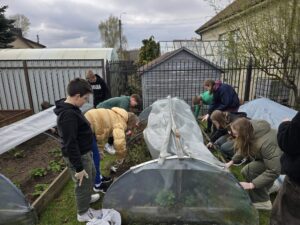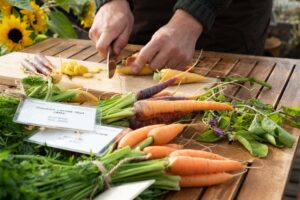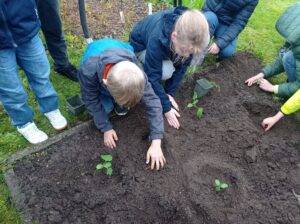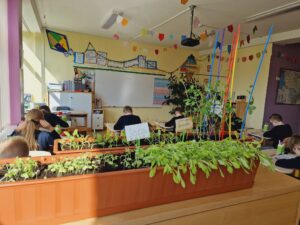
Responding to climate change by teaching children how to grow food and nurture biodiversity
Students from 32 schools in Šiauliai, Kaunas and Klaipėda got involved in such practical activities, the opportunity to observe the germination of seeds in the classroom to grow microgreens, and to plant and harvest wheat and vegetables in the school yard. Together with their peers from Iceland and the Faroe Islands, they are participating in the project “See, follow and taste!” The goal of the project is to interest the younger generation in growing plants and encourage them to delve deeper into our food path to the plate.
In Lithuania, the project “See, follow and taste!” is implemented in Lithuania by the Office of the Nordic Council of Ministers in cooperation with the Nordic Center for Genetic Resources “NordGen” and the Association of Lithuanian University Botanical Gardens (LUBSA).

“Biodiversity loss and climate change are already challenging the agricultural sector, and given the current global context – the ongoing war in Ukraine and the recent pandemic – it is clear that over-reliance on imported food products makes us vulnerable. In the face of these challenges, it is more important than ever to be able to provide ourselves with food, to discover and learn to grow food crops typical of our region, to include them in our menu”, – convinced Agnė Buraitytė, adviser on climate, environmental protection and digitization issues of the Northern Council of Ministers office in Lithuania.
The school has already reached 290 sets of seeds for educational-experimental activities: “What is a seed?”, “Growing microgreens indoors”, “Four types of grains”, “Same but different”. The first sessions are devoted to observing the germination process and growing various greens in the classroom, and the last two are to grow vegetables and grain crops in the school environment, and to harvest in summer and autumn.
Greens on the windowsill and purple carrots in the beds
Today, very few children help plant crops or harvest crops that come to our homes as food. It’s no wonder that children, and even adults, find it difficult to associate a slice of bread at the supermarket or a carrot for lunch with a tiny seed that was once planted. However, it is our children who will have to continue our work and take care of the planet so that plants will continue to grow on it. All of humanity depends on plants for food, shelter, energy, animal feed, and medicine, so understanding how a seed turns into a plant and what it needs to grow is essential knowledge for everyone, especially the younger generation.

All seed samples are taken from the Nordic seed collection and are vegetables perfectly adapted to grow in the Northern European climate. Students germinate and grow green beans, peas, kohlrabi, cucumbers, clover, thyme, lettuce and spinach in the classrooms. Four main types of grain, which have long been important for the farms of the Nordic and Baltic countries, were chosen for cultivation in the field: wheat, barley, oats and rye.
To explore the genetic diversity of plants, the Same But Different educational kit includes radishes, turnips and carrots – with seeds from up to four different varieties of each vegetable included. This is an opportunity for students to discuss what genetic diversity is, why it is important, what genetic characteristics of seeds may be important for the conditions of the Nordic and Baltic countries, and after harvesting, it will be possible to compare the color, size, and shape of different varieties of vegetables. Perhaps, for some, this will be the first opportunity to taste turnips. Today they are forgotten, but historically they were an important source of food for both people and animals in our region. Many, I believe, will be surprised by the different colored carrots – until the 16th century carrots were purple, cherry, red or black in color and only from the 18th century the usual orange color began to dominate more and more.

All the plants of the project can be seen growing in the botanical gardens of Lithuanian universities. In addition, in May and September, celebrations are planned here, during which we will talk about the need to protect these plants, sustainable eating habits, looking back at the plant cultures typical of our region, but forgotten.

The project is financed by the office of the Nordic Council of Ministers in Lithuania.
